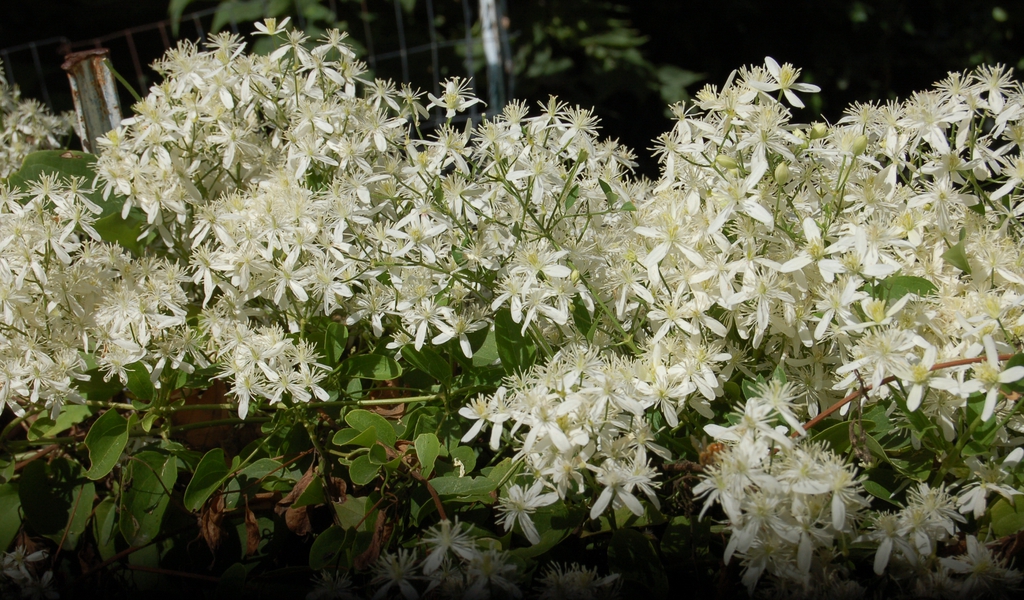Clematis terniflora
Common Name(s):
Previously known as:
- Clematis cuspidatum
- Clematis dioscoreifolia
- Clematis maximowicziana
- Clematis paniculata
- Phonetic Spelling
- KLEM-ah-tiss tern-ih-FLOR-uh
- This plant has high severity poison characteristics.
- See below
- This plant is an invasive species in North Carolina
- Description
-
Japanese clematis is an invasive woody, twining perennial vine in the Ranunculaceae (buttercup) family that is native to Japan and Central and South China. It may rapidly reach 15 to 30 feet high and wide.The showy white flowers appear in late summer.
While it can be beautiful, Japanese clematis is a vigorous grower in full sun or partial shade and spreads by self-seeding, layering, and runners. It has escaped cultivation to invade forest edges, right-of-ways, and areas along streams and roads. It climbs other vegetation, forming dense blankets that block sunlight to the plants underneath. It is considered an invasive species, particularly in the East, including North Carolina, Alabama, Delaware, Florida, Georgia, Illinois, Maryland, New Jersey, South Carolina, Tennessee and Virginia
Insects, Diseases, and Other Plant Problems: This is a weedy and poisonous invasive species and alternatives should be considered. Please see the suggestions in the left-hand column. This plant is listed as invasive by the NC Invasive Plant Council. Common problems include aphids, vine weevils, leaf spot, stem rot, and powdery mildew.
VIDEO created by Grant L. Thompson for “Trees, Shrubs, and Woody Vines for Landscaping” a plant identification course offered by the Department of Horticulture at Iowa State University.
- Profile Video:
- See this plant in the following landscape:
- Cultivars / Varieties:
-
- Tags:


































- Cultivars / Varieties:
-
- Tags:
-
-
Attributes:
- Genus:
- Clematis
- Species:
- terniflora
- Family:
- Ranunculaceae
- Life Cycle:
- Perennial
- Woody
- Recommended Propagation Strategy:
- Layering
- Seed
- Stem Cutting
- Country Or Region Of Origin:
- Central & South China to Japan.
- Distribution:
- It has naturalized in many parts of the USA, particularly in the East and Midwest.
- Climbing Method:
- Twining
- Dimensions:
- Height: 15 ft. 0 in. - 30 ft. 0 in.
- Width: 15 ft. 0 in. - 30 ft. 0 in.
-
-
Whole Plant Traits:
- Plant Type:
- Ground Cover
- Shrub
- Vine
- Woody Plant Leaf Characteristics:
- Deciduous
- Semi-evergreen
- Habit/Form:
- Climbing
- Dense
- Spreading
- Growth Rate:
- Rapid
- Maintenance:
- High
- Texture:
- Medium
-
-
Cultural Conditions:
- Light:
- Full sun (6 or more hours of direct sunlight a day)
- Partial Shade (Direct sunlight only part of the day, 2-6 hours)
- Soil Texture:
- Clay
- Loam (Silt)
- Soil Drainage:
- Good Drainage
- Available Space To Plant:
- 12-24 feet
- NC Region:
- Coastal
- Mountains
- Piedmont
- USDA Plant Hardiness Zone:
- 5a, 5b, 6a, 6b, 7a, 7b, 8a, 8b, 9a
-
-
Fruit:
- Fruit Color:
- Brown/Copper
- Cream/Tan
- White
- Fruit Value To Gardener:
- Showy
- Display/Harvest Time:
- Fall
- Fruit Type:
- Achene
- Fruit Description:
- Plume-like seed heads (clusters of 5-6 fruits connected at the heads and each having a long white tail). The large achenes are ovoid and flattened in shape; they are thinly covered with appressed silky hairs.
-
-
Flowers:
- Flower Color:
- Cream/Tan
- White
- Flower Inflorescence:
- Panicle
- Flower Value To Gardener:
- Fragrant
- Showy
- Flower Bloom Time:
- Fall
- Flower Shape:
- Cross
- Star
- Flower Petals:
- 4-5 petals/rays
- Colored Sepals
- Flower Size:
- 1-3 inches
- Flower Description:
- Flowers bloom in late summer (August) to fall (October) and are produced in terminal branching panicles of 3-12 flowers. Each monoecious flower has four pure white, narrow, petal-like sepals, approximately 50 stamens, and 5-10 pistils with long, plumose styles
-
-
Leaves:
- Woody Plant Leaf Characteristics:
- Deciduous
- Semi-evergreen
- Leaf Color:
- Green
- Leaf Feel:
- Glossy
- Leathery
- Leaf Type:
- Compound (Pinnately , Bipinnately, Palmately)
- Leaf Arrangement:
- Opposite
- Leaf Shape:
- Cordate
- Deltoid
- Elliptical
- Ovate
- Leaf Margin:
- Entire
- Hairs Present:
- No
- Leaf Length:
- 1-3 inches
- Leaf Width:
- 1-3 inches
- Leaf Description:
- 3-5 leaflets with apically round and basally cordate leaflets can be toothed on young plants but are entire when mature. The long petioles of these compound leaves can lean or bend around neighboring objects for support; tendrils are not present.
-
-
Bark:
- Bark Color:
- Light Brown
- Surface/Attachment:
- Shredding
- Bark Description:
- longitudinally shredded bark on mature stems
-
-
Stem:
- Stem Color:
- Brown/Copper
- Green
- Stem Is Aromatic:
- No
- Stem Description:
- Shallowly-grooved stems grow from a tap root, starting out green and developing light brown, longitudinally shredded bark on mature stems.
-
-
Landscape:
- Attracts:
- Bees
- Resistance To Challenges:
- Black Walnut
- Deer
- Diseases
- Insect Pests
- Problems:
- Invasive Species
- Poisonous to Humans
- Problem for Cats
- Problem for Children
- Problem for Dogs
- Problem for Horses
- Weedy
-
-
Poisonous to Humans:
- Poison Severity:
- High
- Poison Symptoms:
- Clematis can cause severe mouth pain and ulcers if eaten. Toxic to dogs, cats, horses. Clinical signs are salivation, vomiting, diarrhea. In humans, symptoms may include dizziness, confusion, fainting, and convulsions. Fatalities are rare, due to the rapid and intense bitter taste and mouth irritation from eating. Gastric lavage is recommended and anti-inflammatory to soothe irritated tissue. Contact dermatitis results in skin redness and burning sensation for some people, gardening gloves are recommended.
- Poison Toxic Principle:
- protoanemonin
- Causes Contact Dermatitis:
- Yes
- Poison Part:
- Leaves
- Sap/Juice















